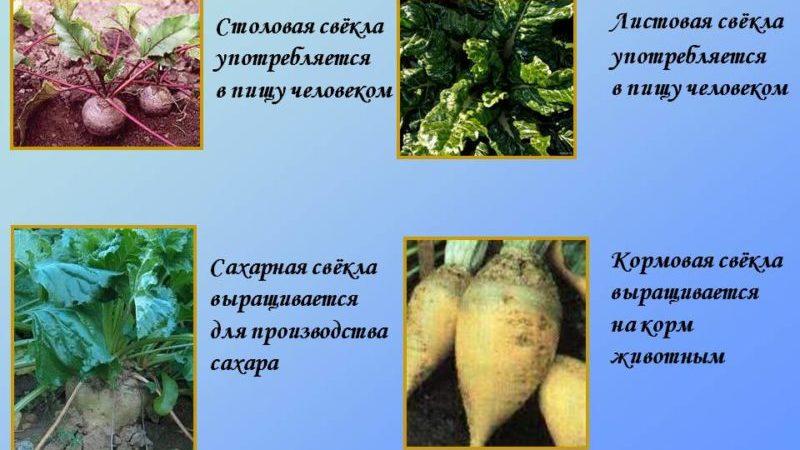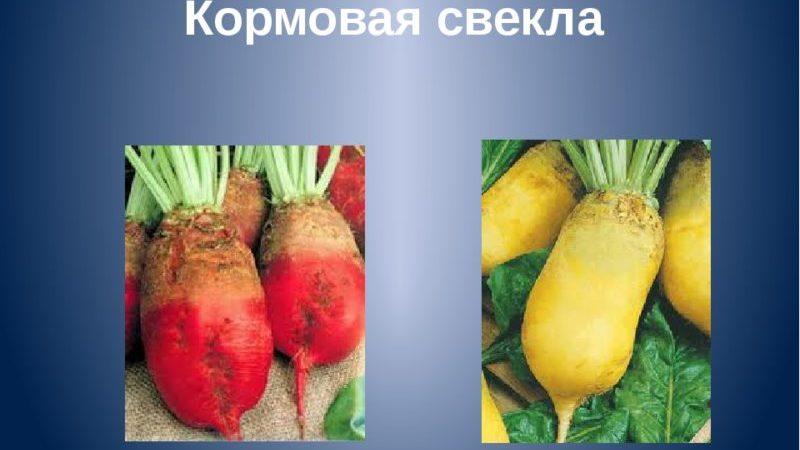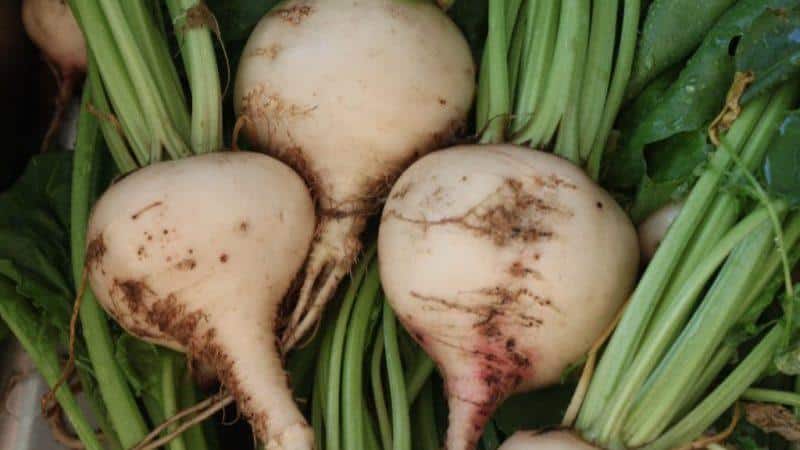What is the difference between fodder beet and sugar beet: difference in appearance, areas of application and other parameters
According to historians, the ancient Babylonians were the first to use beets, although so far only as a medicine. And the ancient Greeks believed that it was this root vegetable that gave a person strength and youth. Centuries have passed since then, and contemporaries still use beets both as food and as medicine. At the same time, the vegetable has undergone many changes thanks to the work of breeders and was divided into numerous varieties.
In this article we will talk about such varieties of beets as sugar and fodder. You will learn further what their differences are and how they are used.
What is the difference between the types
Fodder (beet) and sugar beets differ from each other in many respects. It's not just about the appearance, but also about the composition, as well as the scope of application. So, let's take a closer look at the main differences between these subspecies.

Chemical composition
This is the most important quality indicator of a vegetable. Fodder beets contain 5-8 g of carbohydrates, 9 g of proteins and 1 to 3% sucrose.
Sugar beets have a completely different composition: 20 g of carbohydrates, 0.12 g of protein and about 20% sucrose. This group of root beet varieties was developed through selective breeding. At the beginning of the 19th century, the sugar concentration in sugar beets was only 5-7%.
Differences in depth of growth
The first sign by which sugar beets can be distinguished from fodder beets is the depth of growth. Sweet root vegetables are always completely in the soil, with only the tops outside.
The fodder is usually located a few centimeters above the ground, sometimes even two-thirds of the length of the entire vegetable without tops. Because of this, the above-ground part of fodder beets fades in the sun. It also makes manual harvesting easier, which cannot be said about machine harvesting.
Appearance
It is also easy to understand by appearance which vegetable is in front of you. So, what is the visual difference between one variety and another?
Sugar beet:
- elongated shape;
- color white, beige, gray;
- the tops are dense (50-60 leaves), green;
- the leaves are small, inconspicuous, light green.
Fodder beet:
- round or oval shape;
- color red, pink, orange;
- the tops are less dense (35-40 leaves), beet-colored, green;
- the leaves are small, ovoid, glossy, green.
Features of care
At this point, we’ll start with the choice of soil, since fodder and sugar beets have different requirements.
Chernozem and sierozem soils and peat bogs are suitable for sugar varieties. Before planting them, it is advisable to grow winter wheat or barley in the intended location. The soil horizon should ideally hold water at a depth of 70 cm.
Forage varieties feel better on slightly alkaline, saline soils. Chernozem will also suit them. The main thing is high fertility and additional feeding. The predecessor crops of beetroot in the garden are cereals, vegetables or legumes.
Rules for caring for sugar beets:
- During germination of seedlings, two thinnings are made - by 5-6 cm and by 15-18 cm.
- Abundant watering immediately after sowing.
- Regular weeding.
- Application of fungicide and insecticide to protect against pests during the growing season.
Rules for caring for fodder beets:
- A few days after sowing and after rain, loosening is carried out.
- It is necessary to weed several times during the growing season.
- Avoid watering a month before digging.
- Use mineral fertilizers.
- Apply Nitroammofoska to the soil before planting.
Productivity
This indicator also varies between beet and sugar varieties. In the first case, the average harvest amount is 30-60 tons per hectare of land. In the second - 15-30 tons.
The best varieties of beetroot:
- Lada;
- Hope;
- Milan;
- Vermont;
- Jamon;
- Starmon.
The best sugar varieties:
- Bohemia;
- Bona;
- Araksia;
- Big Ben.
Areas of use
Sugar beets are widely used in sugar production. In Russia it is the main resource for sugar production.
Black molasses is also obtained from these varieties. It is a dark brown, syrupy liquid, a byproduct of sugar production from beets or cane. Another name for molasses. It is used in dishes such as ribs in sweet sauce and certain types of beer. It is believed that this is not only a tasty, but also a healthy product. The tops are used to feed livestock or to fertilize the soil.
Fodder beets are used to feed livestock. It has a beneficial effect on the milk of domestic animals qualitatively and quantitatively. During the cold season, it helps to obtain the necessary vitamins, microelements and proteins.
Read also:
How to use beets for weight loss.
Will beets help with constipation and how to use them correctly to normalize stool.
For which animals is fodder beet grown?
This type of root vegetable is suitable for cows, pigs, goats, chickens and even rabbits.
Cows I love this vegetable very much. It significantly increases their milk yield and increases the fat content of milk. The daily norm is no more than 18 kg.And 15 days before calving, it is necessary to stop feeding this crop.
For goats the effect is similar. The daily norm for an adult goat is 4-5 kg.
When are root vegetables and beet tops consumed? chickens, the shell of their eggs becomes stronger, the yolk acquires a beautiful bright yellow color, and the health of the bird itself improves.
Pigs You can give the vegetable both raw and boiled. Since beets normalize digestion and fat metabolism, eating them by pigs increases their body weight while reducing the amount of fat.
Rabbits They actively eat both the tops and roots of beets. It improves the appearance of their fur and the taste of the meat. In addition, digestion and general health are normalized. So, regardless of the purpose of keeping rabbits, beetroot is useful for them.
How to distinguish these two types visually
For clarity, the photo below shows sugar beets and fodder beets. It is easy to distinguish them by appearance. The main thing is to remember the main points:
- Sugar - white, fodder - burgundy-pink.
- Sugar - elongated, stern - round.
These are the main distinguishing features that will not allow you to doubt the definition.


Let's sum it up
Despite the presence of a common ancestor, fodder and sugar beets are completely different root crops in purpose, composition and appearance. What’s most interesting is that people themselves do not eat any of these varieties. The usual beetroot on our table is table beets. And sugar and feed varieties are used for other needs, also necessary for humans.